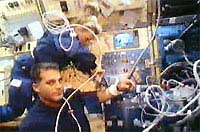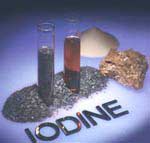Turn urine into drinking water for astronauts
With Water Security's special filtration device, spacecraft waste water will be processed for reuse, even astronauts' urine is also recycled into pure drinking water.

In the field of space exploration, the supply of water to astronauts on orbit is one of the crazy calculations of scientists. Over the past five years, the US Aerospace Agency (NASA) has spent about $ 60 million to bring drinking water to the space station through space shuttles (every gallon of water moves to the air for about $ 40,000. ). However, this cost is likely to be reduced thanks to a recent successful test. Scientists have found a more viable alternative: recycling urine and domestic wastewater from astronauts.
This is not a very unique initiative, but implementing it in the narrow space of a spacecraft in a weightless state is not a simple thing, and many also wonder if its taste will be like how?
Using a water reuse system at the space station will reduce the amount of water needed to move into space to two-thirds and the space on the spacecraft is enough to accommodate four other astronauts.
Water Security is located in Reno, Nevada, USA, a newly established company that aims to exploit NASA's technology at the earth's environment. Company Director Ray Doane eagerly showed off the mystical box and said: 'This is a great breakthrough technique' . Water Security has added a special filtration device to NASA's system, creating a new filtration system that can eliminate up to 99.9% of all bacteria in the water, into a purely purified water source.
Water Security's water filtration system consists of 6 steps , starting with a basic filter to remove debris or large debris, such as hair or fibers, from the initial liquid. Next, a carbon filter removes the organic waste materials in urine such as urea, uric acid and creatinine, as well as germicides or bactericidal agents that often come from field water sources. The liquid is then pumped through a system designed by Water Security, which includes a lot of synthetic iodine microparticles. When any microorganisms touch these particles, they release iodine to kill the microorganisms.
 The vice president of the company, Mr. Ken Kearney said: ' Iodine is slowly absorbed into the water and is very stable under wide environmental conditions and alkalinity. This system can also solve all the most contaminated water sources on the planet and provide safe, clean water . ' Water will be retained for a while in the tank to help iodine have enough time to destroy all microorganisms. Then a filtration system removes iodine, nitrate salts and heavy metals. Finally, water is directed through a filtration system to remove cryptosporidium (a type of water parasite that is immune to iodine) and provides a purely clean water source.
The vice president of the company, Mr. Ken Kearney said: ' Iodine is slowly absorbed into the water and is very stable under wide environmental conditions and alkalinity. This system can also solve all the most contaminated water sources on the planet and provide safe, clean water . ' Water will be retained for a while in the tank to help iodine have enough time to destroy all microorganisms. Then a filtration system removes iodine, nitrate salts and heavy metals. Finally, water is directed through a filtration system to remove cryptosporidium (a type of water parasite that is immune to iodine) and provides a purely clean water source.
For a long time, NASA engineers have been thinking a lot about human waste. Alan Shepherd's first 15-minute orbital flight was so short that no one thought of designing a urine receptacle in an astronaut suit. In this 15-minute period, an electrical problem occurred, causing him to be delayed for 86 minutes without returning. Shepherd's bladder soon became full and he called the center for the first time. After considering it, the control center replied, "Dispose of it in your flight suit ." Later, astronauts on the Gemini and Apollo spacecraft were equipped with a plastic bag covering the lower body. After decanting, the crew was asked to seal the bag and mix it with an antiseptic liquid to create the desired ' stable waste '.
According to a NASA study in 1975, generally the Apollo waste treatment system satisfies relatively well from a technical point of view. But from the crew's general point of view, this system is completely unstable. For the shuttle, NASA designed a $ 23 million toilet system that can dry waste, then bring it back to earth.
Water Security's water filtration system allows NASA to solve two problems at the same time.It solves the problem of waste water, while recycling urine into drinking water for astronauts. NASA is testing this system at the Marshall Space Operations Center in Huntsville, Alabama. In addition, Water Security has begun using its technology in many places without clean water supplies.
This summer, the International Child Care Agency built a water filtration system in northern Iraq. Robert and Roni Anderson, the founders of the agency, built the system on a dedicated Toyota vehicle and brought it to dozens of villages to provide clean water. This system provides an average of 5 gallons of water per minute, during a day of water purification it can provide water to a village of 5,000 people for a whole month. The average cost is about 3cent / 1 gallon.
Not only are war-torn areas lacking water. After the tsunami struck Indonesia in December 2004, many clean water sources were contaminated with salt and contaminated by the street. Kearney said Water Security's water filtration system could handle such disasters. In general, this technique has been tested in a waste water area in Jakarta and provided the water met the standards set by the environmental protection organization.
- 'Millions of dollars' is spent on filtering urine into drinking water
- Successfully manufactured equipment to turn urine into beer water
- Turn urine into drinking water in the universe
- Removing billions of space tourism: Customers must also drink recycled urine
- Astronauts use recycled urine
- Do you know humans drinking dinosaur urine?
- How to go to the toilet?
- Urine recycling machine irritates astronauts
- 9th graders 'turn' air conditioner waste into drinking water
- Drinking water this way, cancer, diabetes will never reach you
- Water drinking habits to remember
- Astronauts will drink from toilet ...
 'Barefoot engineer' invents a pipeless pump
'Barefoot engineer' invents a pipeless pump Process of handling dead pigs due to disease
Process of handling dead pigs due to disease Radiometer
Radiometer Warp Engine: Technology brings us closer to the speed of light
Warp Engine: Technology brings us closer to the speed of light